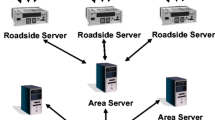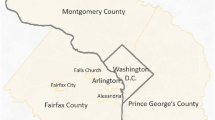Abstract
Due to the continuous growth of traffic and transportation and thus an increased urgency to analyze resource usage and system behavior, the use of computer simulation within this area has become more frequent and acceptable. This chapter presents an overview of modeling and simulation of traffic and transport systems and focuses in particular on the imitation of social behavior and individual decision-making in these systems. We distinguish between transport and traffic. Transport is an activity where goods or people are moved between points A and B, while traffic is referred to as the collection of several transports in a common network such as a road network. We investigate to what extent and how the social characteristics of the users of these different traffic and transport systems are reflected in the simulation models and software. Moreover, we highlight some trends and current issues within this field and provide further reading advice.
Similar content being viewed by others
References
Alam, S. J., & Werth, B. (2008). Studying emergence of clusters in a bus passengers’ seating preference model. Transportation Research Part C: Emerging Technologies, 16(5), 593–614.
Bazzan, A. L. (2005). A distributed approach for coordination of traffic signal agents. Autonomous Agents and Multi-Agent Systems, 10, 131–164.
Ben-Akiva, M., & Lerman, S. R. (1985). Discrete choice analysis: Theory and application to travel demand. Cambridge, MA: MIT Press.
Boxill, S., & Yu, L. (2000). An evaluation of traffic simulation models for supporting ITS development (Technical Report, SWUTC/00/167602-1). Houston, TX: Center for Transportation Training and Research, Texas Southern University.
Chen, X., & Zhan, F. B. (2008). Agent-based modeling and simulation of urban evacuation: Relative effectiveness of simultaneous and staged evacuation strategies. Journal of the Operational Research Society, 59(1), 25–33.
Chung, E., & Dumont, A.-G. (2009). Transport simulation: Beyond traditional approaches. Lausanne: EFPL Press.
Davidsson, P., Henesey, L., Ramstedt, L., Törnquist, J., & Wernstedt, F. (2005). An analysis of agent-based approaches to transport logistics. Transportation Research Part C: Emerging Technologies, 13(4), 255–271.
Davidsson, P., Holmgren, J., Persson, J. A., & Ramstedt, L. (2008, May 12–16). Multi agent based simulation of transport chains. In L. Padgham, D. Parkes, J. Müller, & S. Parsons (Eds.), Proceedings of the 7th international conference on autonomous agents and multiagent systems (AAMAS 2008) (pp. 1153–1160), Estoril, Portugal. Richland, SC: International Foundation for Autonomous Agents and Multiagent Systems.
Davidsson, P., & Verhagen, H. (2017). Types of simulation. In Simulating social complexity—A handbook. Chapter 3 in this volume.
de Jong, G., & Ben-Akiva, M. (2007). A micro-simulation model of shipment size and transport chain choice. Transportation Research Part B, 41(9), 950–965.
Dia, H. (2002). An agent-based approach to modelling driver route choice behaviour under the influence of real-time information. Transportation Research Part C, 10(5–6), 331–349.
Dia, H., & Panwai, S. (2007). Modelling drivers’ compliance and route choice behavior in response to travel information. Nonlinear Dynamics, 49, 493–509.
Ehlert, P. A. M., & Rothkrantz, L. J. M. (2001). Microscopic traffic simulation with reactive driving agents. In Proceedings of intelligent transportation systems 2001 (pp. 860–865). IEEE: Oakland, CA.
El Hadouaj, S., Drogoul, A., & Espié, S. (2000). How to combine reactivity and anticipation: The case of conflict resolution in a simulated road traffic. In S. Moss & P. Davidsson (Eds.), Multi-agent-based simulation: Second international workshop, MABS; revised and additional papers (lecture notes in computer science, 1979) (pp. 82–96), Boston, MA, Berlin: Springer.
Esser, J., & Schreckenberg, M. (1997). Microscopic simulation of urban traffic based on cellular automata. International Journal of Modern Physics C, 8(5), 1025–1036.
Fischer, K., Chaib-draa, B., Müller, J. P., Pischel, M., & Gerber, C. (1999). A simulation approach based on negotiation and cooperation between agents: A case study. IEEE Transactions on Systems, Man, and Cybernetics–Part C: Applications and Reviews, 29(4), 531–545.
Gambardella, L. M., Rizzoli, A., & Funk, P. (2002). Agent-based planning and simulation of combined rail/road transport. Simulation, 78(5), 293–303.
Goldberg, J. B. (2004). Operations research models for the deployment of emergency services vehicles. EMS Management Journal, 1(1), 20–39.
Gruer, P., Hilaire, V., & Koukam, A. (2001, October 7–10). Multi-agent approach to modeling and simulation of urban transportation systems. In Proceedings of the 2001 IEEE international conference on systems, man, and cybernetics (SMC 2001) (Vol. 4, pp. 2499–2504), Tucson, AZ.
Hemelrijk, C. (2017). Simulating complexity of animal social behaviour. In Simulating social complexity–A handbook. Chapter 24 in this volume.
Hensher, D. A., & Ton, T. T. (2000). A comparison of the predictive potential of artificial neural networks and nested logit models for commuter mode choice. Transportation Research Part E, 36(3), 155–172.
Holmgren, J., Davidsson, P., Persson, J.A., & Ramstedt, L. (2007, June 24–28). An agent based simulator for production and transportation of products. In Proceedings of the 11th World Conference on Transport Research, Berkeley, CA.
Hunt, J. D., & Gregor, B. J. (2008, September 25–27). Oregon generation 1 land use transport economic model treatment of commercial movements: Case example. In K. L. Hancock (Ed.), Freight demand modeling: Tools for public-sector decision making; summary of a conference, (TRB conference proceedings, 40) (pp. 56–60), Washington DC: Transportation Research Board.
Jin, X., Abdulrab, H., & Itmi, M. (2008, June 1–6). A multi-agent based model for urban demand-responsive passenger transport services. In Proceedings of the international joint conference on neural networks (IJCNN 2008), part of the IEEE world congress on computational intelligence, WCCI, IEEE. (pp. 3668–3675), Hong Kong, China.
Koorey, G. (2002). Assessment of rural road simulation modelling tools (Research Report, 245). Wellington: Transfund New Zealand. http://ir.canterbury.ac.nz/bitstream/10092/1561/1/12591251_LTNZ-245-RuralRdSimulatnTools.pdf
Klügl, F., & Rindsfüser, G. (2007). Large-scale agent-based pedestrian simulation, MATES 2007, LNAI 4687, (pp. 145–156), Springer-Verlag Berlin Heidelberg.
Kumar, S., & Mitra, S. (2006). Self-organizing traffic at a malfunctioning intersection. Journal of Artificial Societies and Social Simulation, 9(4). http://jasss.soc.surrey.ac.uk/9/4/3.html
Lee, S., Kim, Y., Namgung, M., & Kim, J. (2005). Development of route choice behavior model using linkage of neural network and genetic algorithm with trip information. KSCE Journal of Civil Engineering, 9(4), 321–327.
Li, T., van Heck, E., Vervest, P., Voskuilen, J., Hofker, F., & Jansma, F. (2006) Passenger travel behavior model in railway network simulation. In Proceedings of the 2006 Winter Simulation Conference. IEEE.
Mahmassani, H. S. (2005). Transportation and traffic theory: Flow, dynamics and human interaction. In Proceedings of the 16th international symposium on transportation and traffic theory. Oxford: Elsevier.
Mandiau, R., Champion, A., Auberlet, J.-M., Espié, S., & Kolski, C. (2008). Behaviour based on decision matrices for a coordination between agents in a urban traffic simulation. Applied Intelligence, 28(2), 121–138.
Meignan, D., Simonin, O., & Koukam, A. (2007). Simulation and evaluation of urban bus-networks using a multiagent approach. Simulation Modelling Practice and Theory, 15, 659–671.
Nagel, K., & Schreckenberg, M. (1992). A cellular automaton model for freeway traffic. Journal de Physique I, 2(12), 2221–2229.
Ortúzar, J. D., & Willumsen, L. G. (2001). Modelling transport (3rd ed.). Chichester: Wiley.
Panwai, S., & Dia, H. (2005, September 13–16). A reactive agent-based neural network car following model. In Proceedings of the 8th international IEEE conference on intelligent transportation systems, IEEE, (pp. 375–380), Vienna, Austria.
Pelechano, N., O’Brien, K., Silverman, B., & Badler, N. (2005). Crowd simulation incorporating agent psychological models, roles and communication (Technical Report). Pennsylvania: Center for Human Modeling and Simulation, University of Pennsylvania.
Pursula, M. (1999). Simulation of traffic systems–an overview. Journal of Geographic Information and Decision Analysis, 3(1), 1–8.
Qi, Z., Baomin, H., & Dewei, L. (2008). Modeling and simulation of passenger alighting and boarding movement in Beijing metro stations. Transportation Research Part C, 16, 635–649.
Ramstedt, L. (2008). Transport policy analysis using multi-agent-based simulation. Doctoral dissertation no 2008:09, School of Engineering, Blekinge Institute of Technology, Karlskrona.
Rossetti, R., Bampi, S., Liu, R., Van Vleit, D., & Cybis, H. (2000). An agent-based framework for the assessment of driver decision-making. In Proceedings of the 2000 IEEE intelligent transportation systems (pp. 387–392). Dearborn, MI: IEEE.
Santos, G., & Aguirre, B. E. (2005, June 10–11). A critical review of emergency evacuation simulation models. In R. D. Peacock & E. D. Kuligowski (Eds.), Proceedings of the workshop on building occupant movement during fire emergencies (pp. 27–52). Gaithersburg, ML: National Institute of Standards and Technology.
Schreckenberg, M., & Selten, S. (2004). Human behaviour and traffic networks. Berlin: Springer.
Strader, T. J., Lin, F. R., & Shaw, M. (1998). Simulation of order fulfillment in chains. Journal of Artificial Societies and Social Simulation, 1(2). http://jasss.soc.surrey.ac.uk/1/2/5.html
Swaminathan, J., Smith, S., & Sadeh, N. (1998). Modeling supply chain dynamics: A multiagent approach. Decision Sciences Journal, 29(3), 607–632.
Tapani, A. (2008). Traffic simulation modeling of rural roads and driver assistance systems (Doctoral thesis). Linköping: Department of Science and Technology, Linköping University.
Terzi, S., & Cavalieri, S. (2004). Simulation in the supply chain context: A survey. Computers in Industry, 53(1), 3–17.
Toledo, T. (2007). Driving behaviour: Models and challenges. Transport Reviews, 27(1), 65–84.
van der Zee, D. J., & van der Vorst, J. G. A. J. (2005). A modelling framework for supply chain simulation: Opportunities for improved decision making. Decision Sciences, 36(1), 65–95.
Wahle, J., & Schreckenberg, M. (2001). A multi-agent system for on-line simulations based on real-world traffic data. In Proceedings of the 34th annual Hawaii international conference on system sciences (HICSS ‘01), IEEE.
Williams, I., & Raha, N. (2004). Review of freight modelling (Final report). Cambridge: DfT Integrated Transport and Economics Appraisal.
Author information
Authors and Affiliations
Corresponding author
Editor information
Editors and Affiliations
Rights and permissions
Copyright information
© 2017 Springer International Publishing AG
About this chapter
Cite this chapter
Ramstedt, L., Törnquist Krasemann, J., Davidsson, P. (2017). Movement of People and Goods. In: Edmonds, B., Meyer, R. (eds) Simulating Social Complexity. Understanding Complex Systems. Springer, Cham. https://doi.org/10.1007/978-3-319-66948-9_26
Download citation
DOI: https://doi.org/10.1007/978-3-319-66948-9_26
Published:
Publisher Name: Springer, Cham
Print ISBN: 978-3-319-66947-2
Online ISBN: 978-3-319-66948-9
eBook Packages: Computer ScienceComputer Science (R0)




